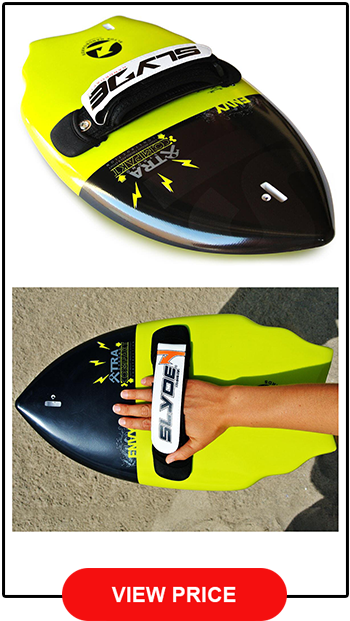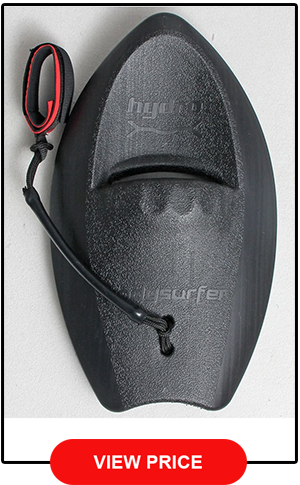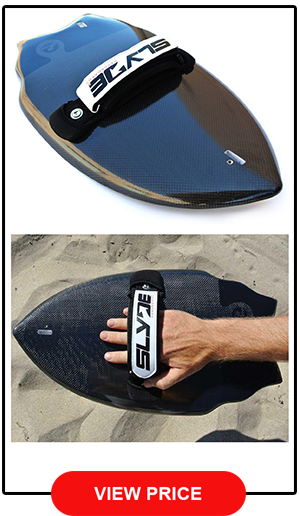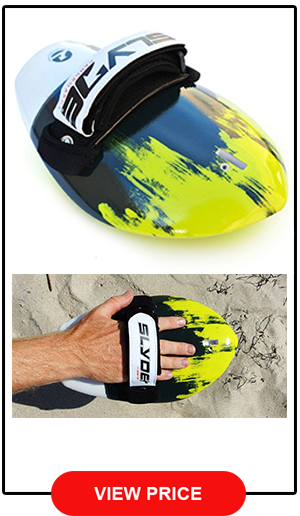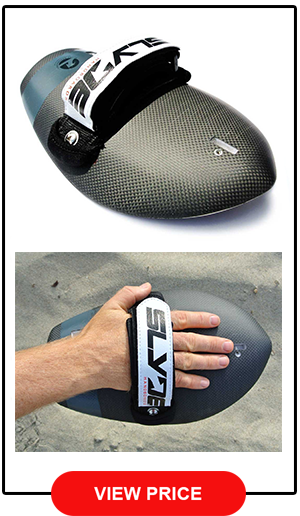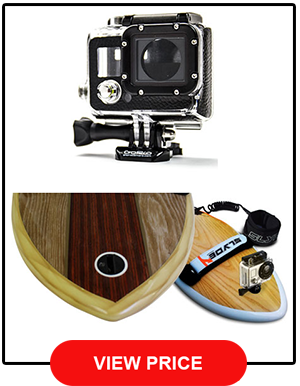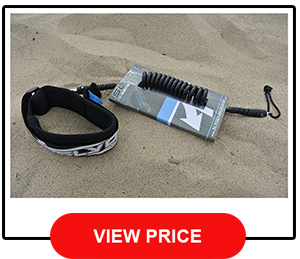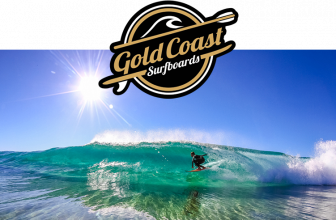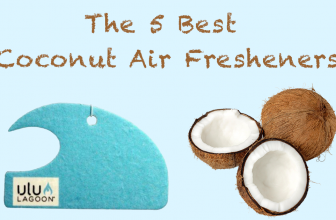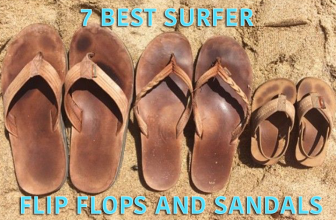
You’ve seen these folks in the lineup as you sit atop your surfboard. Their heads bobbing on the water’s surface, they look like swimmers except they’re not swimming.
They’re waiting for that next peeling wave, just like you are. When it comes, you see them catch it and bodysurf down the line past you with the smallest looking surfboard you’ve ever seen attached to their forward hand.
More...
The next thing you see is their face, up out of the water and laughing from the incredible thrilling ride.
Makes you want to try it, this handboard bodysurfing. Except, where do you start? Well . . . you can start here with this ultimate guide.
Top 5 Best Handboards
Beginner
Slyde Envy Wedge Handboard
Excellent choice for the novice or the skilled, as well as for kids and adults, this handboard has a high-density urethane foam core for excellent buoyancy, feather lightness, and strength.
The adjustable Velcro hand strap is padded, and anchored to the board with “never-come-out” double-posted inserts.
The high-density foam core has a coat of 2-oz Triaxial fiberglass covered with a 3-mm PPX “Flax Jacket” that is exceedingly durable yet lightweight.
The rails are not prone to crack or split due to the doubly reinforced hardened resin layer used. It has a swallowtail, “winged” rails and concave bottom channels to let water out the back yet prevent spray back.
This handboard is best in 1-7 foot waves, but can be used in bigger waves as well. It has a leash insert and a Go-Pro insert, and comes with a 1-year manufacturer’s warranty covering nearly everything.
At 19.8” long, 10.1” wide, and weighing only 22-ounces, take this Slyde anywhere easily and use it in any type of wave.
Hydro Bodysurfing Handboard
The Hydro handboard is molded from durable and slick polypropylene plastic.
The extra-strength Velcro hand strap padded for comfort holds your hand in place while still allowing you to shift your weight distribution for increased maneuverability and speed.
This board is wafer thin, ergonomically designed with a bit of rocker, and has a textured hand piece for a better grip.
Channels along the bottom and edged rails allow water to flow out the back while keeping you tight in the wave’s pocket.
This translucent-colored board comes with a floatable wrist leash, is extremely lightweight, and is 12” long by 7” wide.
Slyde Carbon Black Wedge Handboard
A very similar board to the Envy Wedge model by Slyde, it’s great for beginners, accommodates a more skilled rider, and can be used by kids and adults.
This board has a thicker urethane foam core for increased buoyancy, decreased drag, and feather lightness. The added buoyancy gets your body higher up out of the water for more speed down the line.
It has the trademark adjustable Velcro hand strap that is padded and anchored to the board with “never-come-out” double-posted inserts.
The high-density foam core coated with 2-oz Triaxial fiberglass and covered with a 3-mm PPX “Flax Jacket” additionally has a layer of grade-A carbon fiber for outstanding strength and durability.
The rails are a doubly reinforced hardened resin layer. It has a swallowtail, “winged” rails and concave bottom channels that lets water out the back without any spray back.
This sturdy handboard is best in 1-7 foot waves, but it performs beautifully on larger waves too.
It has a leash insert and a Go-Pro insert, and comes with a 1-year manufacturer’s warranty covering nearly everything.
At 19.8” long, 10.1” wide, and only 2.2-pounds, it packs and travels easily.
Advanced
Slyde Hawaiian Bula Enoka Handboard
Hawaiian handboard bodysurfing champion and shaper Sean Enoka played a major role in the shaping of this board.
Deeply concave with a sharp chine to the rails give this board a superior grip on steep waves, an effortless cut through pounding shore breaks, and reliable control on vertical takeoffs.
Constructed with high-grade urethane foam covered in a layer of 2-oz Triaxial fiberglass and coated with a 3-mm PPX “Flax Jacket”, this board is amazingly strong for being feather weight.
Like all Slyde handboards, the adjustable Velcro hand strap is padded and anchored to the board with “never-come-out” double-posted inserts, and its rails are reinforced with double epoxy resin.
It comes with a leash insert and a Go-Pro insert, and a 1-year manufacturer’s warranty covering nearly everything.
At 11.8” long and 2.4” wide, it weighs only 14-oz. Best in shore breaks and excellent for waves over 3-feet. It’s called the “barrel hunter” for a good reason!
Slyde Hawaiian Bula Carbon Fiber Black Handboard
Sleek, robust and powerful, this handboard will propel you on waves like no other. Handboard champion and Kaha Nalu Hawaii founder Sean Enoka designed and tested this board.
Like the Bula Enoka handboard, the deeply concave shape and distinct chine-edged rails provide the rider with confidence whether they are steep, hollow waves or punching through shore breaks.
The exact weight-to-strength ratio comes from the combination of a high-grade urethane foam core for buoyancy, a grade-A carbon fiber layer for amazing strength and durability, and a coating of 2-oz Triaxial fiberglass and 3-mm PPX “Flax Jacket”.
The “never-come-out” trademark hand strap is similar to that found on other Slyde handboards – comfortable, padded, adjustable, and anchored securely.
It comes with a leash insert and a Go-Pro insert, and a 1-year manufacturer’s warranty covering nearly everything.
Built and designed for top performance riders, this board works best in shore breaks as well as waves well over 3-feet.
Use this 11.8” long, 2.4” wide, 14-oz board for advancing your handboarding skills.
Handboard Accessories
GoPro Attachment
Most handboards on the market now come with an insert for easy mounting of mount your GoPro camera.
With this method, the camera mount is firm and secured safely onto the board to decrease your risk of losing it, especially in pounding surf.
A second way of mounting your GoPro is to use the industrial-strength waterproof adhesive mounts you can purchase for your camera. These mounts come in flat and curved shapes, and are removable with applied heat from a hair dryer.
The nice thing about the adhesive mounts is that the camera can be placed anywhere on the handboard, not just where the handboard company placed their insert for the mount.
Usually, however, handboard makers have put a lot of research time into figuring out the best camera placement for their boards, and the reinforced inserts offer more security against losing your camera.
Leashes
Unless you want to spend time swimming in to shore to retrieve a lost handboard, get a leash, but spend the money to buy one your happy with – it’s insurance for your handboard as well as your safety.
There are two ways to go with leashes: wrist or bicep attachment. Leashes for the wrist are shorter than for the bicep and tend not to wrap around you.
With a bicep leash, you want to make sure it features things like swivels, elasticity, and a coiled cord to keep from entangling you.
One nice thing about bicep leashes, you can easily switch hands on your board without having to change the leash arm as well or having the leash interfere with paddling.
Slyde Handboards Bicep Pro Coil Leash
Slyde handboards have a built in plug insert for easy attachment. Their Pro Coil leash meets all the criteria you’d want to have in a handboard bicep leash.
The sturdy nylon cord ties to the board’s plug easily. A double, stainless-steel swivel design keeps you free from tangles at both the bicep end and board end.
The 7-mm flexible cord has 14 tightly ringed coils and stretches to 43”. The bicep connection point has double stitching for added security.
The cuff itself is a well padded neoprene for comfort with a strong-holding Velcro wrap around and quick release nylon pull tab at the end.
How To Use A Handboard For Bodysurfing
The board goes on your dominant hand, which is the hand most comfortable in the forward position, and lays palm down on the board. The hand strap should fit snuggly with little or no play, and not fall off when moving your hand around.
Either swim with regular swimming strokes or put the handboard on top of the water and place your other hand on top, then stretch out forward and kick with your swim fins. When a wave approaches, stretch your arm with the handboard out in front of you and kick hard to catch it; you can also swim stroke the other arm for added momentum.
Being in the right place for catching a wave requires a fast enough push forward yet not too much – too fast and you will get ahead of the wave, but too slow and you will watch the wave roll over you.
When learning, just go straight and don’t worry about turning down the line. Stay as prone as possible, imagine your body as a rigid surfboard, and use your fins as rudders. Oh, don’t forget to smile!
How To Make A Handboard For Bodysurfing
The simplest design is a flat, handplane-type board. There are heaps of resources and tutorials online for DIY handboard making, so be sure to check these out. Here’s one of the simplest ways to make your own handboard.
First, draw an outline of your shape onto paper; best to fold the paper and draw only one-half so that each side is symmetrical. Next, trace your outline onto wood, like 10-ply premium plywood that is marine- or furniture-grade, for example. Then, use a jigsaw to cut your shape, erring on the outside of the lines (you can always sand off the extra bit) and going slow to avoid continually nicking the rails and making them jagged. At this point, choose which side you want to be the top. Find where your hand will lay atop the board, and mark two places to define the span of your knuckles – for example, from the tail measure about 2/3rd of the way up (or where the curve of the nose hits the strait of the rail), and mark one place for the index finger and another for the pinkie.
Time to sand! On the top side of the board, sand the straight lengths of the rails so they curve down (or the length from your knuckle holes to the tail) yet leave the underside part of the rail untouched except for light sanding to smooth any sharpness. Additionally, do the same across the tail width, and round off the each tail edge. Now, flip the board over to work on the underside. Turn up the nose by sanding the same curve-down shape you did for the rails. Start turning up the nose right where you stopped turning down the rail. Leave the top side part of the nose untouched except for light sanding to smooth any sharpness. On the underside of the board, sand a shallow 4” wide channel starting from the middle of your board and finishing at the tail. The shallowest depth could be around 1/4” and you can always make it deeper from there.
Get the drill out and make two 1/2″ holes where you marked for your knuckles all the way through the board. Flip to the underside, and in the same two holes, drill larger 3/4″ holes but only halfway through the board. The knots of your hand strap webbing will nestle in this larger divot and be flush with the bottom. Seal your board with teak oil or waterproofing varnish and coat the entire thing – even the insides of the holes just drilled. Finally, thread 16″ climbing webbing through both holes, tie knots for each making sure it’s tight but that your hand can still slide under snugly. Cut off any excess webbing melt the ends with a lighter to avoid frayed ends. You can sew a neoprene padding for your hand strap, but be sure to do this prior to fitting and attaching the hand strap. Now, go play.
FAQ’s
How To Care For A Handboard?
After every use in saltwater, immediately rinse your handboard with fresh water. Be sure to get a good rinse around leash swivels, any fabric and hand strap attachment areas. Let it air dry but keep it out of the sun and don’t leave it stored in your hot car day after day. If you hang your handboard for storing and you have a coiling leash, coil the ringed part around a dowel to keep it tight, and avoid letting the leash hang and stretch out over time. Bag and pad the board well whenever you travel.
How Long Does A Handboard Last?
How long your handboard lasts depends upon the durability of the board, your specific handboarding habits, how you store it when not in use, and how many times you loan it out to friends who want to try it!
Where Can I Buy A Bodysurfing Handboard?
Find handboards online through the companies that make them or at local distributors.
What Else Besides A Handboard Do I Need For Bodysurfing?
You need swim fins for that push for catch waves and rudder action for steering and speed control. A leash is great, but optional. Also, a wetsuit if you want, because your body will be totally submerged and the water will wick heat from your body.
What Waves And Beaches Do I Use A Handboard At?
Most any type of beach will do, but nice sandy ones as opposed to rocky ones are best. Waves can be anything in size, from knee-high and mushy, to overhead and steep, or from beach shore dumpers to clean, glassy gliders. Do find the right wave for the board you have, however. Some designs work specifically better on certain types of waves.
Is It Hard To Use A Handboard?
It’s likely easier than you think, however, you do need some shoulder and arm strength, leg strength for kicking with fins, and a keen awareness of the board, which can knock you in the face or head when surfing rough, dumping beach and shore breaks.
Do You Use Wax On A Handboard?
If your board lacks a good handgrip, then yes, wax it. If there is a textured handgrip, then no, unless you’re hand is still slipping.
How Necessary Is a Handboard For Bodysurfing, Do I Need One?
Bodysurfing requires no equipment and is a lot fun. Handboards and swim fins provide the bodysurfer an extra pull forward and push from behind when catching waves, easier planing down the line, more control of your speed and direction, increased buoyancy that means less drag, and better floatation for hanging out in the lineup waiting for the next wave.
Do Handboads Float?
Yes, if made from a material that floats. Handboards work best when they are neutrally buoyant, that is, they float but also penetrate the water easily.
Do You Need A Leash For A Handboard?
No, except they are good at preventing having to swim ashore to retrieve your wayward board.

